This page contains affiliate links. We may earn money or products from the companies mentioned in this post through our independently chosen links, which earn us a commission. Learn More
 Akita Inu is a dog breed that originated from the mountains in the northern regions of Japan, and it’s one of the six native Japanese dog breeds. It’s a large dog breed at about 26 to 28 inches tall, weighing between 70 to 130 pounds. The lifespan of Akita’s is around 10 to 15 years.
Akita Inu is a dog breed that originated from the mountains in the northern regions of Japan, and it’s one of the six native Japanese dog breeds. It’s a large dog breed at about 26 to 28 inches tall, weighing between 70 to 130 pounds. The lifespan of Akita’s is around 10 to 15 years.
Confident and loyal with a bit of an unpredictable streak, this dog is an affectionate companion towards family members but can be aloof with strangers.
There are two breeds of Akita: the Japanese Akita and American Akita. The United States considers both varieties to be of the same breed, but the rest of the world separates the two. In this post, we will focus on the Japanese Akita.
Contents & Quick Navigation

What is the Akita Inu?
This purebred originates from the mystic Northern mountainous regions of Japan. The earliest mention of this dog can be traced back to the 1600s and the Matagi dog – the native ancestor of the Akita Inu.
These Japanese dogs were bred for size, hardiness, and power. With high levels of intelligence, ferocity, and agility, Akitas were used for hunting deer and bear. Their prestige grew, and in 1931, the Akita Inu was recognized as a Japanese National Monument.
The Akita Inu may be revered, but its story is one of pure survival. This breed endured some dark moments in time that almost brought about its extinction.
During World War II, with resources, medical aide, and morale low amongst the Japanese population, the government ordered that all non-military dogs be slaughtered to prevent the spread of disease. They were also used for food and furs.
True passion for the breed saved the Akita Inu. Amidst the despair and darkness of war, Akita owners took their beloved canines to where no one would dare to go find them, to where the breed had come to be – the wilderness of the Northern mountains.
With a single chance at survival through freedom, these Akitas returned to the wild and bred back with the Matagi. This cross-breeding solidified the future of the Akita Inu.
Just for fun: 4 Akita Inu facts
- Helen Keller harbored a special interest in this breed. In 1937 she travelled to Japan and was presented with two dogs of her own. These Akitas became the very first of their kind to enter the US.
- Hachiko is mega-famous in Japanese culture. He is regarded as the ultimate symbol of loyalty. Long story short, he would sit and wait at the local train station for his human to return from work every day without fail. Tragically, his human passed away, but, still, Hachiko sat and waited at the station – for 9 years! There is a bronze statue of him in Japan. During WWII, it was melted down to make weapons but was resurrected once again when the war came to an end.
- There is an Akita Dog museum located in Odate, Japan. Yup, it’s totally dedicated to this breed. Guess who is behind the inspiration? Good ol’ Hachiko!
- Sadly, dog fighting is still permitted in many parts of Japan, and Akitas are prime candidates for fights. Interestingly enough, before a fight, the dogs are decked out in “armor”, so to speak. Also, they do not fight to the death. A match is stopped before either opponent is fatally wounded.
What Does the Akita Inu Look Like?
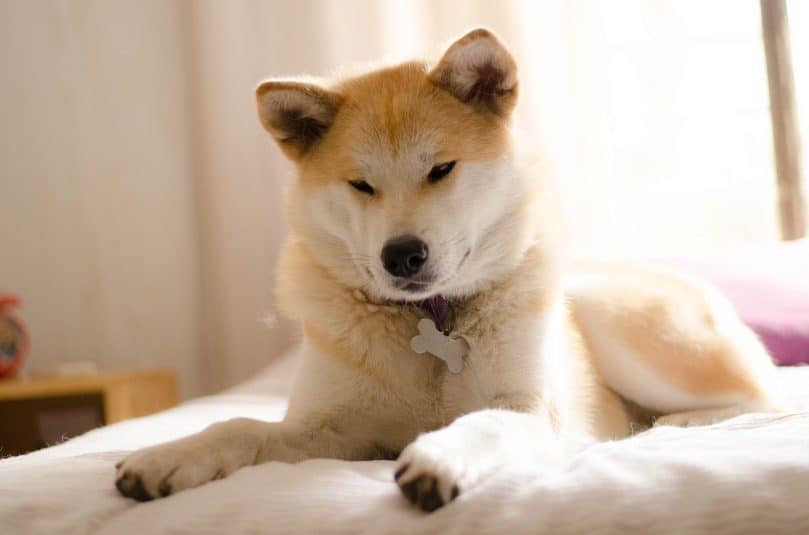
This is an attractive dog bred for strength and hunting prowess. As mentioned above a full-grown Akita Inu stands up to 26-28 inches (66-70 cm) in height and weighs up to 70-130 lbs (31-58 kg).
The Akita has a bit of a wolfish look with its thick coat, observant eyes, and pointed ears. The signature Akita tail is held high, laying in a curly Q shape across the loins.
It features a short double-coat that serves to keep it warm in the snowy mountains of the North. The Japanese Akita coat comes in a specific range of colors (to be considered purebred). This includes red, white, or brindle.
If you suffer from allergies, then know that the Akita Inu is not hypoallergenic. They are heavy shedders, especially during the spring and autumn seasons.
If you don’t mind a bit of fur here and there, daily brushing will help keep shedding at a minimum.
Breed comparison: Shiba Inu vs Akita Inu

Shibu Inu
The Shiba Inu is another highly popular purebred hailing from Japan. While these two breeds share many similar characteristics when it comes to temperament and behavior, size is their major difference.
The Shiba is smaller, growing up to 18 inches in height and weighing up to 21 lbs. It is considered a medium-sized dog.
Because of its smaller stature, the Shiba Inu is seen as a companion dog, although it has been used to hunt birds and other small critters.
Breed comparison: American Akita vs Japanese Akita
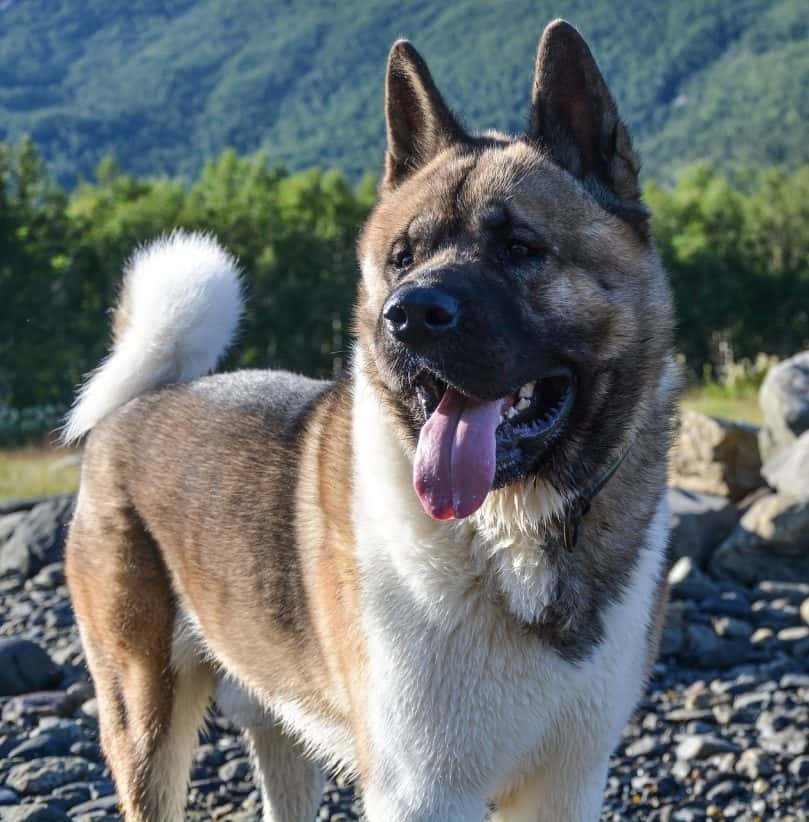
American Akita
As mentioned above, only in the US are these two considered to be of one identical breed. Alas, the American Akita comes from a separate Dewa Line (less favored lineage in Japan). The Japanese Akita is of the Ichinoseki Line.
American Akitas inherited the larger body size, wrinkled forehead, and bigger ears of the Dewa dogs while the Japanese Akitas are smaller and unwrinkled.
Coat color is also a big differentiator. American Akitas come in all different shades of white, brown, brindle, black, or red. The Japanese Akita, however, is accepted as purebred with a coat that is white, red, or brindle.
Temperament-wise, these breeds are similar. They are known to be confident, alert, and fiercely loyal with the domineering instinct that makes for excellent hunting and guard dogs. Both are also skeptical of strangers and other canines.
Breed comparison: Akita Inu vs Husky
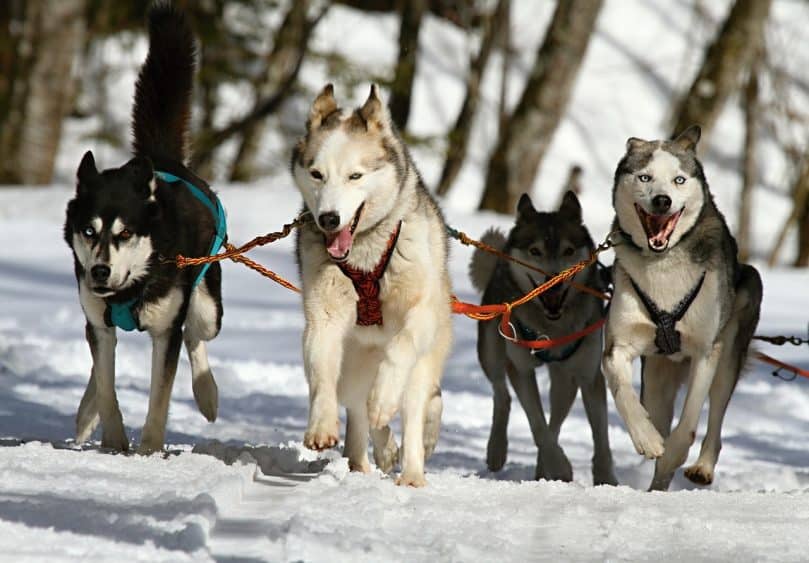
Husky
Huskies and Akitas are similar in size, have the same wolf-like features and dense coats, and are naturally adapted to cold environments. However, they are distinctively different breeds of dog.
The biggest difference is in temperament. The Husky is a gentle, lovable family dog, while the Akita is shy, can be unpredictable and is not recommended for first time dog owners due to the training and socialization that is needed.
Akitas were bred to be hunting dogs, so that alpha instinct is strong. Huskies are working dogs that look to follow commands and please, with no will to be dominant over their owner.
Breed comparison: Akita Inu vs German Shepherd
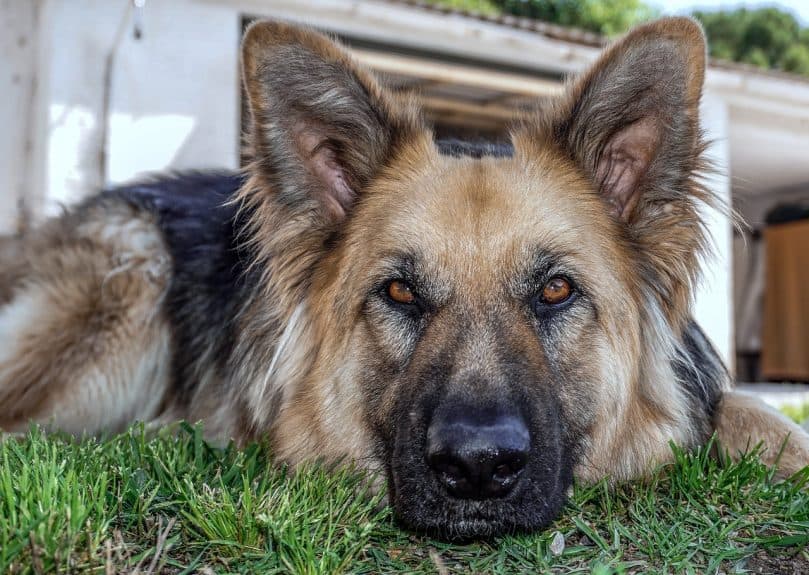
German Shepherd
Here is another wolf-like purebred dog that shares many similarities with the Akita Inu in terms of temperament.
The German Shepherd (GSD) wasn’t bred for hunting like the Akita, but it makes one heck of a good guard dog. It is known for characteristics such as loyalty, protectiveness, and skepticism towards strangers and unfamiliar dogs.
Both share the reputation of being an aggressive breed, with devout training recommended to mold proper behavior.
While the Akita Inu is affectionate towards family and children, the German Shepherd is the more popular family dog.
The GSD is also highly intelligent. They respond fast to training and are used as service dogs as well as for police and military work.
Is the Akita Inu Dangerous?
When it comes to personality, the Akita Inu dog is one of a kind. Some say it’s complicated, while others say it’s just a bit aloof. This cold unpredictability or shyness is what renders an intimidating reputation. After all, a shy or fearful dog may react by either retreating or attacking out of defense.
The Akita Inu is known to be strong-willed and stubborn, so it takes a passionate and patient owner to make sure training is implemented. This will build trust and tame dominant tendencies. Ironically, though this breed is weary of strangers and other dogs, it adores children.
You can expect this powerful and independent dog to be protective and serious, with a dignified temperament. The Akita doesn’t like to be teased, so you better think twice about playing games with its food bowl during chow time. Don’t even think about sharing its toys!
Because the Akita Inu can be difficult to train, has an unpredictable temperament and is physically powerful, it is not recommended for first time dog owners.
Akita Inu with babies
This breed is known to be affectionate towards its family, especially children. But it’s always a good idea to never leave any dog alone with babies and toddlers.
Akita Inu with other dogs
Akita Inu is territorial around other dogs, especially of the same sex. It is recommended to keep the Akita on a leash if you visit the dog park, as it is not well-suited for off-leash activities.
Akita Inu as a guard dog
These dogs are alert, protective, and large. They are often used as police and military dogs. Therefore, this breed does make a good guard dog if trained properly.
Akita Inu Quirkiness
Akitas LOVE to be clean – it’s a big deal for them! They’ll take time to dust the crumbs off their faces after a meal, preen other pets, and prefer only the freshest spots in the house when it’s time for a nap.
In fact, this breed is often compared to a cat due to its independent, calm nature and inclination towards cleanliness.
Akita Inu training tips
Training an Akita Inu is not for the faint of heart. You need to be ready to dedicate a serious amount of time and energy into working with her. So, if you have a busy work schedule or aren’t home very often, this may not be a good breed for you.
Akitas need heaps of socialization from the time they are puppies. It’s important to be firm with your commands and always use positive reinforcement with some doggie treats or praise.
The most vital element of successful training is staying consistent, especially with socialization. This way, you can curb the Akita’s shyness and skepticism towards other people.
In this video you can watch an Akita Inu taking part in obedience training.
Akita Inu bite force
The American Akita has a bite force with a PSI between 300 and 400 lbs, so we can assume that the Japanese Akita’s jaws have a similar PSI rating. Let’s see how it compares against other dog breeds so we can get a better understanding about its strength.
- Akita Inu vs German Shepherd: A German Shepherd has a bite strength with a PSI of 238 lbs. It’s safe to say that the Akita is the stronger guard dog. It’s no surprise, though, since it was bred to hunt feral dogs in Japan.
- Akita Inu vs Labrador: With a bite force of 230 lbs, the Labrador jaw is not as strong as the Akita.
- Akita Inu vs Pitbull: The Pitbull is used for dog fighting and guarding like the Akita, but it has weaker bite strength with a PSI of 235 lbs. It’s also smaller in size than the Akita.
Does the Japanese Akita Need A Lot of Maintenance?
The Akita Inu needs maintenance not only in the training department, but with health as well.
As mentioned in the first paragraph this breed has a lifespan of 10 to 15 years. Despite this dog’s long life expectancy, Akita Inu health problems need to be regarded carefully.
These are the most common issues associated with the breed.
- Progressive Retinal Atrophy: A genetic disease that affects the eyes, leading to loss of sight or blindness.
- Hip Dysplasia: This is a debilitating and painful hip joint deformity that is genetic. It can lead to loss of mobility and lameness.
- Bloat: A condition that occurs after eating, when the stomach fills with gas and twists painfully. This disrupts blood flow to the heart, causing the dog to go into shock. Without immediate medical attention, death can occur.
- Von Willebrand’s Disease: A missing protein that helps blood to clot.
- Autoimmune Thyroiditis: This is the most common cause of primary hypothyroidism in dogs, in which an increased metabolism affects many organ functions in the body.
It is also imperative to note that Japanese Akitas tend to be sensitive to vaccines. Make sure to bring this topic up with the vet to eliminate any concerns.
Keeping Akita toned & trim
Like any dog, a healthy lifestyle is paramount to bolster longevity and keep diseases at bay. The Akita needs space to move (they are large dogs after all). We don’t recommend the Akita Inu for apartment life. They fare much better in a house with a fenced-in yard.
Thanks to their mostly docile temperament, Akitas don’t have high energy levels. However, they will be destructive where your precious belongings are concerned if boredom sets in.
Light exercise for at least 30 minutes a day will keep them well-behaved and in shape. A brisk walk around the neighborhood or a run in the backyard should suffice.
Akita Feeding
You’ll want to feed your Akita Inu 3 to 5 cups of high-grade dry dog food a day. An animal protein should be incorporated, such as chicken or fish, along with grains such as barley or brown rice.
How Much Does an Akita Inu Puppy Cost?

If you’ve decided that the brave and loyal Akita Inu is the canine for you and you’re looking for Akita Inu puppies for sale, be prepared to pay up to $2000 for a pup from a reputable breeder. Anything you see lower than $700 – walk away. This price smells fishy… or, should I say, puppy mill-ish.
Speaking of puppy mills, it is important to be extra-cautious and responsible when shopping for your new four-legged-love.
Jumping on the first breeder you find because you’re impatient is not a good idea. Neither is buying a puppy online. There are numerous puppy-mills out there waiting to take advantage of dog lovers with cute pictures of fluffy pups and outrageously low prices.
The truth is, puppy mills are horrendous establishments where parent dogs are bred to exhaustion and puppies grow up in dire conditions. It is not uncommon for them to have poor genetics and diseases.
So, before you race to your Akita Inu, do your research to find the best breeder. Here are our top tips to get you on the right track.
- Plan to visit where the puppies are kept to learn how they grew up. Did they get plenty of sunshine and fresh air? Is the environment clean and sanitary? Were they able to roam freely as opposed to being locked up in cages? These are all significant details you should think about when visiting a breeder. The breeder should be more than happy to have you over. If a breeder refuses, this is definitely shady. What does he have to hide?
- Inquire about the parents. One of the most important tips for buying a puppy is to find out who its parents are or if they are even around the breeding premises for you to meet. Not only does this give insight into how a puppy will possibly look or act as it grows, but it gives insight into any health concerns. Since the Akita Inu is prone to a number of health problems, many of which are genetic, you can check the medical history of each parent.
- Don’t forget to ask for health clearances!
- Be prepared to answer questions yourself. A person decides to become a dog breeder out of passion and love for the breed, right? If so, a reputable breeder won’t sell to just anyone. They should be interested in getting to know you. They might ask where you live, if you have a yard, and how often you work. They want to ensure that their sweet puppy is going to a good home with a caring owner that has time and financial means to give proper care.
The Japanese Akita Club of America is a great place to start looking for a puppy. They have a full directory of ethical Japanese Akita breeders.
Akita Inu Adoption & Rescue
Perhaps the price tag for a new Akita puppy is a bit too high for your taste. If that’s the case, adoption is always an option.
This breed is definitely special, meaning it requires an attentive and dedicated owner that can take the time for training and development. Many people buy Akitas because of the beauty factor or even because of the tough reputation they have as guard dogs.
Unfortunately, some find the responsibility of caring for this dog too overwhelming. Many Akitas end up in rescues.
If you are interested in adopting, check out these establishments dedicated to the welfare of Akita Inus. Remember that since the US considers both the Japanese and American Akita the same, these rescues feature both types.
Conclusion: Is This the Breed For You?
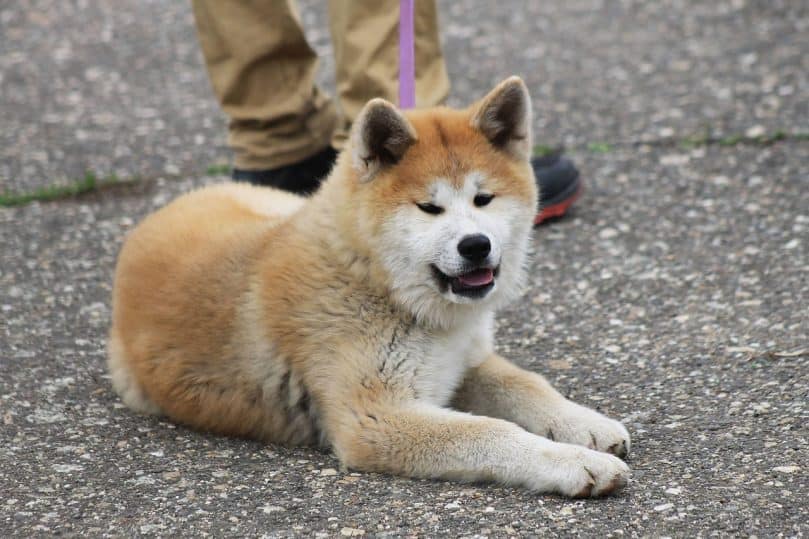
The Japanese Akita Inu is a special breed of dog with a colorful history that only adds to its uniqueness.
A skilled hunter built for life in the cold, this dog is always keeping an eye out for danger. They tend to be territorial, protective of family members, and skeptical towards strange people and dogs.
They are also shy and prefer their independence. All of these factors, including their muscular build, make them unpredictable when it comes to aggressive behavior.
That’s why we do not recommend this breed for first-time dog owners. If you are passionate about Akitas and have the time available, be prepared to invest in heavy socialization and training.
Despite the attention required for the care of the Japanese Akita, it truly is a magnificent creature. Its feline tendencies for cleanliness add to its quirkiness, and the famous Akita Inu loyalty renders a soft spot for affection. If you show this dog love and dedication, it will reciprocate in spades.
What do you think about the Japanese Akita Inu? Tell us in the comments!

1 reply on “Akita Inu: An Ancient Breed From the Land of the Rising Sun”
The most important thing is that the person getting the Akita, go to shows and start a new relationship with the breeders, you have to go to a different place to get a good home for your Akita. I’m sure you will get some great experience and a sense of humor and love the Akita has. I have had 6 over my 43 years of experience. Papers are the most important part of your experience and the history of your life long friend who has been there to lay down for you if you’re ever near someone who has bad intentions. Dog shows are very important and is a very good fit. wait for the call to come get your family members just let them know that you are going to take a look at it. The Akita will pick you !and the 2 of you should walk around the house to make sure that the best time and place is a great example of how to get ahold of the 1st Akita dogs are very easy and want to please you and your family, I had a female and needed to give her a home with children. she was a great fit and would let the children be able to goof on her and at night she would make the necessary arrangements, and the children were in bed, and when all the house was in bed she would take place next to the alpha male and lay on the floor next to him,I stopped by to see if there were any problems, she was so excited to see me again and the kids were very well protected from anyone who was not going to cross their fence and then the yard. so if you want to know. don’t let the people push you to the dog.You can always do a rescue for your 1st